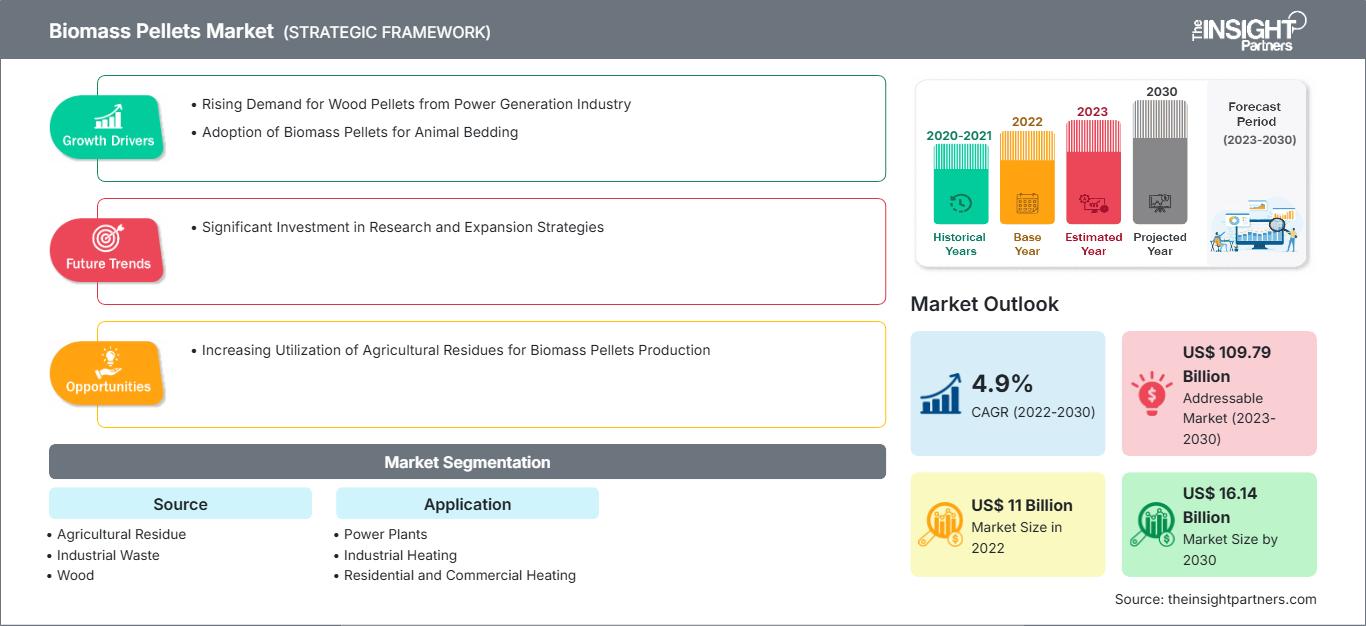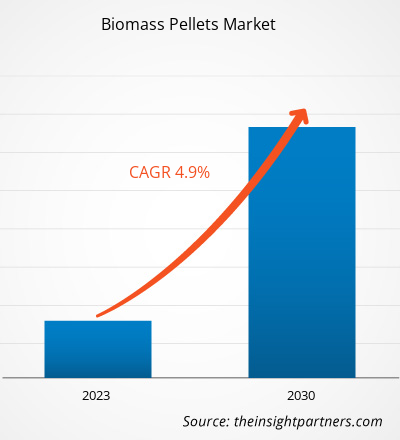[Rapporto di ricerca] Il mercato dei pellet di biomassa è stato valutato a 11.001,59 milioni di dollari nel 2022 e si prevede che raggiungerà i 16.137,89 milioni di dollari entro il 2030; si stima che registrerà un CAGR del 4,9% dal 2022 al 2030.
Approfondimenti di mercato e punto di vista degli analisti:
I pellet di biomassa sono biomassa lavorata ad alta densità, compressa in piccole forme cilindriche. Deriva da materiali organici, come residui agricoli, scarti di legno, trucioli di legno, segatura e residui forestali. I pellet di biomassa sono utilizzati nella produzione di energia e nel riscaldamento in settori residenziali, commerciali e industriali. Presentano numerosi vantaggi rispetto alla biomassa non lavorata, come caratteristiche standardizzate, elevato contenuto energetico, facilità di stoccaggio e facilità di trasporto. I pellet di biomassa, in particolare quelli di legno, sono ampiamente utilizzati nelle stufe e nelle caldaie a pellet residenziali. Gli sforzi del governo per ridurre le emissioni di gas serra e promuovere l'utilizzo di pellet di biomassa stanno trainando la crescita del mercato dei pellet di biomassa.
Fattori di crescita e sfide:
Con la crescente attenzione alla sostenibilità, la domanda di pellet di biomassa, come il pellet di legno, è aumentata in modo significativo. I pellet di legno possono essere utilizzati per la produzione di energia elettrica come alternativa al carbone. Inoltre, i pellet di biomassa hanno una forma uniforme, un'elevata densità e sono adatti al trasporto e allo stoccaggio. La domanda di pellet di legno è cresciuta notevolmente per le applicazioni di generazione di energia. In Europa e Nord America, così come in paesi asiatici come Cina, Giappone e Corea del Sud, i pellet di legno vengono utilizzati principalmente per la co-combustione nelle centrali elettriche a carbone. Si sta verificando un aumento dell'utilizzo di materiali alternativi al carbone nelle centrali elettriche su larga scala in tutto il mondo. Nel 2021, il Ministero dell'Energia indiano ha imposto l'utilizzo di almeno il 5% di pellet di biomassa in miscele di combustibile con carbone in tutte le centrali elettriche a carbone. Tali obblighi stanno trainando la crescita del mercato dei pellet di biomassa in India. Inoltre, le grandi aziende elettriche di diversi paesi europei, come i Paesi Bassi e il Belgio, si riforniscono di pellet di biomassa da Stati Uniti, Russia e Canada, secondo il Dipartimento dell'Agricoltura degli Stati Uniti. Pertanto, la crescente domanda di pellet di legno da parte dell'industria della produzione di energia elettrica sta trainando il mercato dei pellet di biomassa. I pellet di biomassa derivano da materiali organici come legno, residui agricoli e rifiuti industriali. Molti paesi considerano i pellet di biomassa una fonte di combustibile sostenibile; tuttavia, sussistono diverse preoccupazioni ambientali legate ai pellet di biomassa. La combustione dei pellet di biomassa rilascia inquinanti nell'aria, tra cui particolato, ossidi di azoto e composti organici volatili. Inoltre, la produzione di biomassa comporta un consumo significativo di acqua per la lavorazione. Pertanto, le preoccupazioni ambientali relative ai pellet di biomassa stanno ostacolando la crescita del mercato dei pellet di biomassa.
Personalizza questo rapporto in base alle tue esigenze
Potrai personalizzare gratuitamente qualsiasi rapporto, comprese parti di questo rapporto, o analisi a livello di paese, pacchetto dati Excel, oltre a usufruire di grandi offerte e sconti per start-up e università
Mercato dei pellet di biomassa: Approfondimenti strategici

- Ottieni le principali tendenze chiave del mercato di questo rapporto.Questo campione GRATUITO includerà l'analisi dei dati, che vanno dalle tendenze di mercato alle stime e alle previsioni.
Potrai personalizzare gratuitamente qualsiasi rapporto, comprese parti di questo rapporto, o analisi a livello di paese, pacchetto dati Excel, oltre a usufruire di grandi offerte e sconti per start-up e università
Mercato dei pellet di biomassa: Approfondimenti strategici

- Ottieni le principali tendenze chiave del mercato di questo rapporto.Questo campione GRATUITO includerà l'analisi dei dati, che vanno dalle tendenze di mercato alle stime e alle previsioni.
Segmentazione e ambito del rapporto:
Il mercato globale dei pellet di biomassa è segmentato in base a fonte, applicazione e area geografica. In base alla fonte, il mercato dei pellet di biomassa è segmentato in residui agricoli, rifiuti industriali, legno e altri. In base all'applicazione, il mercato dei pellet di biomassa è segmentato in centrali elettriche, riscaldamento industriale, riscaldamento residenziale e commerciale e altri. Per area geografica, il mercato dei pellet di biomassa è segmentato in Nord America (Stati Uniti, Canada e Messico), Europa (Germania, Francia, Italia, Regno Unito, Russia e resto d'Europa), Asia Pacifico (Australia, Cina, Giappone, India, Corea del Sud e resto dell'Asia Pacifico), Medio Oriente e Africa (Sudafrica, Arabia Saudita, Emirati Arabi Uniti e resto del Medio Oriente e Africa) e Sud e Africa. America Centrale (Brasile, Argentina e resto dell'America meridionale e centrale)
Analisi Segmentale:
In base alla fonte, il mercato dei pellet di biomassa è segmentato in residui agricoli, rifiuti industriali, legno e altri. Il segmento del legno detiene la quota maggiore nel mercato dei pellet di biomassa e si prevede che registrerà una crescita significativa nel periodo di previsione. I pellet di biomassa sono prodotti utilizzando scarti di legno come segatura, trucioli, trucioli, corteccia e altri materiali residui generati dalla lavorazione del legno, dalle segherie e dalla lavorazione del legname. Gli scarti di legno vengono raccolti, lavorati, essiccati e pellettizzati. I pellet di biomassa legnosa sono ampiamente utilizzati in applicazioni di riscaldamento residenziale, forni industriali e centrali elettriche.
Analisi Regionale:
In base alla geografia, il mercato dei pellet di biomassa è segmentato in cinque regioni chiave: Nord America, Europa, Asia-Pacifico, America meridionale e centrale e Medio Oriente e Africa. Il mercato globale dei pellet di biomassa è stato dominato dall'Europa, che ha rappresentato circa 6.478 milioni di dollari nel 2022. L'Asia-Pacifico è il secondo maggiore contributore, con oltre il 30% della quota di mercato globale dei pellet di biomassa nello stesso anno. Si prevede che il Nord America registrerà un CAGR di oltre il 4,5% durante il periodo di previsione. In Nord America, il mercato dei pellet di biomassa è significativamente trainato dalla competitività regionale dei costi dei pellet di biomassa rispetto al gasolio per riscaldamento residenziale e al propano. La produzione di pellet di legno in Nord America ha guadagnato terreno negli ultimi anni grazie alla crescente domanda dai mercati esteri. Secondo il Dipartimento dell'Agricoltura degli Stati Uniti, Stati Uniti e Canada forniscono pellet di legno alle centrali elettriche nei Paesi Bassi e in Belgio. L'aumento della domanda interna di pellet di biomassa nella regione ha spinto i produttori ad espandere le proprie capacità produttive. Nel 2023, Grand River Pellets (Canada) ha investito 30 milioni di dollari per espandere la capacità produttiva di pellet di biomassa da 140.000 a 220.000 tonnellate all'anno. Tutti questi fattori stanno guidando la crescita del mercato dei pellet di biomassa in Nord America.
Sviluppi del settore e opportunità future:
Di seguito sono elencate le varie iniziative intraprese dai principali attori che operano nel mercato dei pellet di biomassa:
- A settembre 2022, Enviva Inc ha inaugurato il suo nuovo stabilimento di produzione di pellet di legno nella contea di George, Mississippi (Stati Uniti). L'impianto ha avviato le attività produttive all'inizio del 2022, raggiungendo una capacità produttiva annua consentita di 750.000 tonnellate metriche all'anno (MTPY).
- Ad aprile 2022, Drax Group PLC ha aperto un nuovo impianto di produzione di pellet a Demopolis, in Alabama, Stati Uniti. L'impianto produce annualmente pellet di biomassa sostenibile da residui di segheria come segatura, trucioli e trucioli.
- A dicembre 2020, Pure Biofuel Ltd. ha lanciato i pellet di legno ENPOWER. I sacchi di pellet di legno ENPOWER rispettano gli standard di qualità A1, stabiliti dal Consiglio del Pellet del Regno Unito e dal Consiglio Europeo. Questo prodotto è disponibile in confezioni da 10 kg o 15 kg.
- Nell'aprile 2021, Drax Group PLC ha acquisito Pinnacle Renewable Energy Inc. Con l'acquisizione, Drax Group PLC ha fornito bioenergia con cattura e stoccaggio del carbonio (BECCS), rimuovendo permanentemente l'anidride carbonica dall'atmosfera ogni anno.
- Nel maggio 2023, LEAG Group ha acquisito Wismar Pellets GmbH da Metropolitan Equity Partners, un investitore di private equity, in una gara d'appalto per espandere il portafoglio di produzione e fornitura delle sue attività di raffinazione. Questa acquisizione aiuterà LEAG Group a servire un numero maggiore di clienti.
Mercato dei pellet di biomassa
Mercato dei pellet di biomassa
Le tendenze regionali e i fattori che influenzano il mercato dei pellet da biomassa durante il periodo di previsione sono stati ampiamente spiegati dagli analisti di The Insight Partners. Questa sezione illustra anche i segmenti e la geografia del mercato dei pellet da biomassa in Nord America, Europa, Asia-Pacifico, Medio Oriente e Africa, America Meridionale e Centrale.
Ambito del rapporto sul mercato dei pellet di biomassa
| Attributo del rapporto | Dettagli |
|---|---|
| Dimensioni del mercato in 2022 | US$ 11 Billion |
| Dimensioni del mercato per 2030 | US$ 16.14 Billion |
| CAGR globale (2022 - 2030) | 4.9% |
| Dati storici | 2020-2021 |
| Periodo di previsione | 2023-2030 |
| Segmenti coperti |
By Fonte
|
| Regioni e paesi coperti | Nord America
|
| Leader di mercato e profili aziendali chiave |
|
Densità degli attori del mercato dei pellet di biomassa: comprendere il suo impatto sulle dinamiche aziendali
Il mercato dei pellet di biomassa è in rapida crescita, trainato dalla crescente domanda degli utenti finali, dovuta a fattori quali l'evoluzione delle preferenze dei consumatori, i progressi tecnologici e una maggiore consapevolezza dei benefici del prodotto. Con l'aumento della domanda, le aziende stanno ampliando la propria offerta, innovando per soddisfare le esigenze dei consumatori e sfruttando le tendenze emergenti, alimentando ulteriormente la crescita del mercato.

- Ottieni il Mercato dei pellet di biomassa Panoramica dei principali attori chiave
Impatto del COVID-19:
La pandemia di COVID-19 ha colpito quasi tutti i settori industriali in diversi paesi. Lockdown, restrizioni di viaggio e chiusure aziendali in Nord America, Europa, Asia-Pacifico (APAC), America Meridionale e Centrale e Medio Oriente e Africa (MEA) hanno ostacolato la crescita di diversi settori, tra cui quello chimico e dei materiali. La chiusura delle unità produttive delle aziende produttrici di pellet di biomassa ha disturbato le catene di approvvigionamento globali, le attività produttive e i tempi di consegna. Diverse aziende hanno registrato ritardi nelle consegne dei prodotti e un crollo delle vendite nel 2020. La maggior parte delle centrali elettriche e degli impianti industriali è stata chiusa durante la pandemia, riducendo il consumo di pellet di biomassa. Inoltre, la pandemia ha causato fluttuazioni nei prezzi dei pellet di biomassa. Tuttavia, diversi settori hanno ripreso le loro attività dopo la risoluzione dei problemi di approvvigionamento. Inoltre, la crescente domanda di pellet di biomassa da parte dei settori industriale e residenziale sta promuovendo in modo sostanziale la crescita del mercato dei pellet di biomassa.
Panorama competitivo e aziende chiave:
Alcuni attori che operano nel mercato globale dei pellet di biomassa includono Drax Group Plc, Enviva Inc, AS Graanul Invest, Lignetics Inc, Valfei Products Inc, Mallard Creek Inc, Energex American Inc., Wismar Pellets GmbH, UAB Redal Ltd e Premium Pellet Ltd. Gli attori che operano nel mercato globale dei pellet di biomassa si concentrano sulla fornitura di prodotti di alta qualità per soddisfare la domanda dei clienti.
- Analisi storica (2 anni), anno base, previsione (7 anni) con CAGR
- Analisi PEST e SWOT
- Valore/volume delle dimensioni del mercato - Globale, Regionale, Nazionale
- Industria e panorama competitivo
- Set di dati Excel
Report recenti
Rapporti correlati
Testimonianze
Motivo dell'acquisto
- Processo decisionale informato
- Comprensione delle dinamiche di mercato
- Analisi competitiva
- Analisi dei clienti
- Previsioni di mercato
- Mitigazione del rischio
- Pianificazione strategica
- Giustificazione degli investimenti
- Identificazione dei mercati emergenti
- Miglioramento delle strategie di marketing
- Aumento dell'efficienza operativa
- Allineamento alle tendenze normative




















 Ottieni un campione gratuito per - Mercato dei pellet di biomassa
Ottieni un campione gratuito per - Mercato dei pellet di biomassa